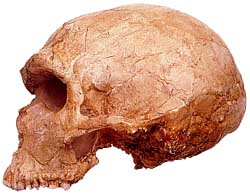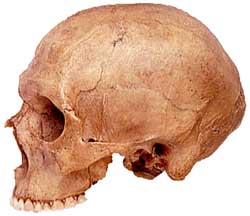DK History: First Modern Humans
Homo sapiens sapiens (modern humans) first evolved between 200,000 BC and 100,000 BC. They were like us, physically, and had the same brain power. They developed many skills of survival, and advanced FLINT-KNAPPING techniques for making better tools.
Most archaeologists think that Homo sapiens sapiens first lived in Africa, and that our direct ancestor was Homo habilis (“handy man”), who evolved about 2.5 million years ago. But some believe our ancestor was Homo ergaster (“work man”), who developed around 1.9 million years ago and settled in different parts of the world.
Like us, Neanderthals are a subspecies of Homo sapiens (“wise man”). They lived in Europe and Asia from c. 130,000 BC to c. 28,000 BC. The spread of modern humans may have been the cause of their extinction.
Wandering groups of modern humans moved out of Africa, in search of food, around 125,000 BC. They reached other continents via land bridges—areas of seabed left uncovered as the Earth’s water froze during the last Ice Age (c. 70,000 BC to c. 10,000 BC). By c. 28,000 BC, they had replaced all earlier humans—including their close relatives, the Neanderthals.
Early and modern humans used a technique called flint-knapping to make stone tools. They chipped flakes off one piece of flint (a hard, glassy stone) by striking it with another piece. This required great patience and skill. ABORIGINALS still practice flint-knapping today.
Early humans used five main kinds of flint tools—knives for cutting, scrapers for removing flesh from hides, burins (small, pointed tools) for carving, awls for piercing holes, and points or tips for attaching to spears. They also used flint hand-axes for chopping wood and butchering animal carcasses.
Aboriginals, also known as indigenous Australians, were the earliest inhabitants of Australia. Until the 20th century, they followed a lifestyle similar to that of earlier humans. Their skills helped archaeologists understand evidence about the distant past.
In 10,000 BC, sea levels around Australia rose and Aboriginal people were forced to move farther inland, where conditions were harsh. To survive, they used fire to clear bushland so that wild food plants could grow, hunted kangaroos with boomerangs, wove traps for fish, and dug grubs from deep underground.



